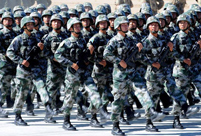 YOG kicks off in Nanjing
YOG kicks off in Nanjing
 Colorful life at Youth Olympic Village of Nanjing 2014 YOG
Colorful life at Youth Olympic Village of Nanjing 2014 YOG
 Royal Taoist temple to open to public
Royal Taoist temple to open to public
 Female soldiers at quake-hit area
Female soldiers at quake-hit area
 Shocking photos of cruel battles in Ukraine
Shocking photos of cruel battles in Ukraine
 Amphibious armored vehicle unit conducts open sea drill
Amphibious armored vehicle unit conducts open sea drill
 Water relay in Henan
Water relay in Henan
 Ethnic culture feasts eyes of travelers
Ethnic culture feasts eyes of travelers
 80 security dogs assembled in Nanjing police dog training base
80 security dogs assembled in Nanjing police dog training base
 Graffiti artists paint on street walls in Xinjiang
Graffiti artists paint on street walls in Xinjiang
BEIJING, Aug. 27 -- Economists and analysts expect more policy easing in the Chinese economy as economic data this month indicating a volatile recovery.
Analysts say the latest data suggest China's economic recovery is losing momentum, and more policy easing needs to be rolled out.
The HSBC/Markit flash manufacturing purchasing managers index (PMI) for August fell to a three-month low of 50.3, down from a final reading of 51.7 in July.
The August Flash PMI reading showed a decline of more than one percentage point in both new orders and output compared to July, indicating a worsening climate for both demand and production.
Qu Hongbin, Co-Head of Asian Economic Research, and Julia Wang, HSBC Greater China Economist, said in a joint research note that July's economic activity data was also softer than expected.
According to the note, fixed-asset investment growth dropped to 15.6 percent in July, with manufacturing and infrastructure investment moderating. In particular, property investment growth slowed further to 11.9 percent after a brief pause in June.
Industrial production slowed due to weak growth in sectors hit by overcapacity. Private sector consumption was weighed down by weak large-ticket spending and jewelry sales, the research note showed.
The Chinese central bank has signalled a preference for quantitative tools such as pledged supplementary lending (PSL), a type of supplementary lending instrument backed by collateral. But a comprehensive cut of the reserve requirement ratio (RRR) for banks or a policy rate cut are also options, the note said.
"With low inflation, there is sufficient room to do so," it added.
Analysts said that monetary policy easing is expected to stay amid a soft recovery as concerns grow over the possibility of interest rate cuts, Meanwhile, the stimulus impact from easing measures adopted since the start of the year is abating.
Such measures included targeted RRR cuts for qualified banks, relaxed standards on loan-to-deposit ratio calculations, and a reported one-trillion-yuan PSL offered by the central bank to China Development Bank Corp to support shanty town renovations.
However, J.P. Morgan China Chief Economist Haibin Zhu said that its forecast for the second half of 2014 is relatively cautious and he does not expect further policy easing.
"Front-loading of fiscal spending implies tighter fiscal measures going forward," Zhu said. Zhu added that policy rates will stay unchanged and credit growth will remain stable, citing the central bank's reiteration of its neutral monetary policy stance.
But new credit flowing into the Chinese economy dropped surprisingly in July. Central bank data showed sharp volatility in credit numbers, with new yuan loans falling to 385 billion yuan in July from over 1 trillion yuan in June. Meanwhile, aggregate financing, which includes RMB loans, grew by just 273 billion yuan in July, down from nearly 2 trillion yuan in June.
The central bank attributed the plunge in July's new credit to multiple factors, including strong financing data in June, flagging demand for loans amid downward pressures on economic growth, drops in deposits, and risk control by banks in the face of rising bad loans.
Xu Gao, Everbright Securities chief economist, worried that the weak credit numbers mean insufficient support for economic growth, whether due to weak demand or banks' reluctance to lend due to risk.
He said that since property sector investment can stimulate related sectors, the sector's growth must be maintained so it can help stabilize economic growth. This means more loosening in the sector is expected, he said.
Amid the downturn in the real estate market, some cities have begun to ease market control measures, including removing purchase limits and lowering minimum down payment requirements on second homes. These measures, along with discounted mortgage rates offered by commercial banks to first-home buyers, are significant and their impact remains to be seen, analysts said.
 Special holidays
Special holidays World's top 10 fighters
World's top 10 fighters 'Stewardesses' serve in hospital
'Stewardesses' serve in hospital Beautiful night scenery of Nanjing
Beautiful night scenery of Nanjing ‘Peace Mission -2014’ joint anti-terror military exercise kicks off in China
‘Peace Mission -2014’ joint anti-terror military exercise kicks off in China Eye-catching guides at the opening ceremony of YOG in Nanjing
Eye-catching guides at the opening ceremony of YOG in Nanjing A female missile launch company of PLA
A female missile launch company of PLA China, the U.S., Britain and the Soviet Union call for Japan's unconditional surrender
China, the U.S., Britain and the Soviet Union call for Japan's unconditional surrender The biggest duty-free store of the world
The biggest duty-free store of the world Volunteers bid farewell to YOG
Volunteers bid farewell to YOG More police dogs join anti-terror campaign in Inner Mongolia
More police dogs join anti-terror campaign in Inner Mongolia Picturesque Dayilan Manchu village in NE China
Picturesque Dayilan Manchu village in NE China Athletes experience the charm of Chinese traditional opera in Nanjing
Athletes experience the charm of Chinese traditional opera in Nanjing Contestants for Miss Bikini World experience Chinese traditional culture
Contestants for Miss Bikini World experience Chinese traditional cultureDay|Week|Month